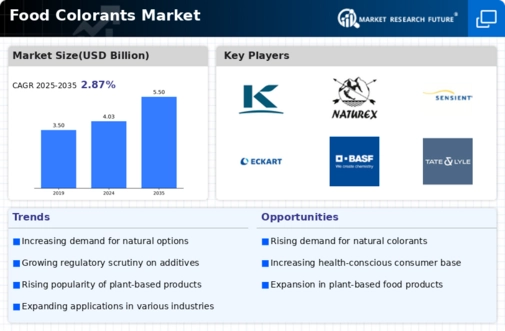Regulatory Support for Food Safety
Regulatory frameworks play a crucial role in shaping the Global Food Colorants Market Industry. Governments worldwide are implementing stringent regulations to ensure food safety and consumer protection. For instance, the European Food Safety Authority (EFSA) and the U.S. Food and Drug Administration (FDA) continuously evaluate food additives, including colorants, to ensure their safety. This regulatory support fosters consumer confidence and encourages manufacturers to invest in compliant colorant solutions. As a result, the industry is likely to witness sustained growth, with projections indicating a market value of 5.5 USD Billion by 2035, reflecting the positive impact of regulatory measures on market dynamics.
Rising Demand for Natural Colorants
The Global Food Colorants Market Industry experiences a notable shift towards natural colorants, driven by consumer preferences for clean-label products. As health-conscious consumers increasingly scrutinize ingredient lists, the demand for natural alternatives to synthetic dyes rises. This trend is reflected in the market's projected growth, with the industry expected to reach 4.03 USD Billion in 2024. Companies are responding by innovating with plant-based colorants derived from sources like beetroot and turmeric, which not only meet consumer expectations but also align with sustainability goals. This transition towards natural colorants is likely to shape the industry's landscape significantly.
Growing Popularity of Functional Foods
The rising trend of functional foods is reshaping the Global Food Colorants Market Industry. Consumers are increasingly seeking foods that offer health benefits beyond basic nutrition, leading to a surge in demand for colorants that also serve functional purposes. For example, colorants derived from superfoods like spirulina not only enhance visual appeal but also provide nutritional benefits. This dual functionality aligns with consumer preferences for health-oriented products, thereby driving market growth. As the industry adapts to these trends, it is likely to see an increase in product offerings that cater to this evolving consumer demand.
Expansion of the Food and Beverage Sector
The continuous expansion of the global food and beverage sector significantly impacts the Global Food Colorants Market Industry. As urbanization and changing lifestyles drive increased consumption of processed foods, the demand for food colorants rises correspondingly. This trend is particularly evident in emerging markets, where a growing middle class seeks diverse and visually appealing food options. The industry's growth is projected to align with this expansion, with estimates suggesting a market value of 4.03 USD Billion in 2024. This correlation highlights the interdependence between food sector growth and the demand for innovative colorant solutions.
Innovations in Food Processing Techniques
Advancements in food processing technologies are significantly influencing the Global Food Colorants Market Industry. Techniques such as microencapsulation and nanotechnology enable the effective use of colorants while enhancing their stability and shelf life. These innovations allow manufacturers to create vibrant and appealing food products without compromising quality. As the industry evolves, the integration of these technologies is expected to drive growth, with a compound annual growth rate (CAGR) of 2.87% projected from 2025 to 2035. This growth trajectory indicates a robust market response to the increasing demand for visually appealing food products.

















Leave a Comment